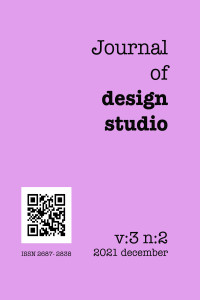Abstract
This article focuses on the effects of the decreased ability to perceive touch in distance learning for all of the actors in architectural design studios during the ongoing Covid-19 pandemic. As part of face-to-face architectural pedagogy, the tactile experience of architectural materials, models, and corporeality in the studio environment assumes great importance. However, in contrast, these aspects are diminished when it comes to digital education, generating new topics for discussion. This article asks how and to what extent distance education models can affect the process of learning, understanding, discussing, and designing architecture, amidst the prospect of continuous digital education in the post-pandemic period. Hence, it examines the awareness and experiences of haptic perception of first-year students at the Istanbul Aydın University Department of Architecture through in-depth interviews recorded on Zoom. Between 2020 and 2021, the interviews investigated haptic perception, observed construction techniques, factors affecting design materials, the way and place in which materials were perceived, the methods of sharing and transferring designs with studio instructors, questions about the obstacles encountered, and expectations for the post-pandemic period. The outcomes of these in-depth interviews showed that there is a close relationship between the students’ bodily interests and their awareness with regards to perceiving materials and that the former indicated a tendency towards making models. It was observed that students had preferred digital design tools in the pre-pandemic period, and in addition to the digital tools that students often use as a design approach, they negotiated as designing through hand-drawing in order to gain the “thinking with one’s hands” experience in this study. This emphasizes the need for haptic experiences in an architectural educational environment.
Keywords
Architectural design studio environment digital environment distance learning haptic learning in distance education multi-modal perception material perception
Supporting Institution
-
Project Number
-
Thanks
We would like to thank to all the students who shared their valuable thoughts for the article.
References
- Altan, İ. (2012). Mimarlıkta Mekan Kavramı. Psikoloji Çalışmaları, 19 (0), 75-88. Retrieved from https://dergipark.org.tr/tr/pub/iupcd/issue/9414/118010.
- Andjelkovic, K. (2020). Kinesthetic Imagination in Architecture: Design and Representation of Space. Život umjetnosti, 106 (1), 22-35. doi: 10.31664/zu.2020.106.02.
- Hamza-Lup, F. G., and Stanescu, I. A. (2010). The Haptic Paradigm in Education: Challenges and Case Studies. Internet and Higher Education, 13 (1-2), 78-81. doi: 10.1016/j.iheduc.2009.12.004.
- Gardner, H. (2011). Frames of Mind, The Theory of Multiple Intelligences. New York: Basic Books.
- Gunawardena, C. N., and McIsaac, M. S. (2004). Distance Education. In D. Jonassen (Ed.), Handbook of Research for Educational Communications and Technology (2nd ed.), 355-395. Association for Educational Communications & Technology. Mahwah, NJ: Lawrence Erlbaum.
- Ibrahim, A. F., Attia, A.S., Bataineh, A’ M., and Ali, H. A. (2020). Evaluation of the Online Teaching of Architectural Design and Basic Design Courses Case Study: College of Architecture at JUST, Jordan. Ain Shams Engineering Journal, 1-9. doi: 10.1016/j.asej.2020.10.006 .
- Karana, E., Barati, B., Rognoli, V., and van der Laan, A. Z. (2015). Material Driven Design (MDD): A Method to Design for Material Experiences. International Journal of Design, 9 (2), 35-54.
- Kauser, N. (2021). Rethinking Architecture Pedagogy in The Era of Pandemics. STHALA, 1, 84-91. Retrieved from https://sjbsap.edu.in/wp-content/uploads/2021/01/file-14-Sthala_VOL_1_Jan_21.pdf.
- Koh, P. C. L., and Khuan Wong, S. (2021). Students’ Perception of Online Learning and Institution’s Engagement During the Covid-19 Pandemic: A Survey Study of Taylor’s Design, Architecture and Engineering Students. Journal of Engineering Science and Technology, 16 (1), 635- 651. Retrieved from http://jestec.taylors.edu.my/Vol%2016%20issue%201%20February%202021/16_1_44.pdf.
- Mallgrave, H. F. (2010). The Architect’s Brain: Neuroscience, Creativity, and Architecture. Oxford: Wiley-Blackwell.
- Masdéu, M., and Fuses, J. (2017). Reconceptualizing The Design Studio in Architectural Education: Distance Learning and Blended Learning as Transformation Factors, Archnet-IJAR: International Journal of Architectural Research, 11 (2), 6-23.
- Moholy-Nagy, L. (1947). The New Vision, Abstract of an Artist. New York: Wittenborn, Schultz, Inc., 4th revised edition (originally published in 1928).
- Nanda, U., and Solovyova, I. (2005). The Embodiment of the Eye in Architectural Education. In E. Harder (Ed.), Writings in Architectural Education, EAAE Prize 2003-2005, Transaction on Architectural Education, 26 (150-161). Copenhagen: From & co.
- Öktem Erkartal, P., and Ökem, H. S. (2015). Mimari Tasarımda Dokunma Olgusu ve Dokunsal Haritalamaya İlişkin Bir Alan Çalışması. Megaron, 10 (1), 92-111. doi: 10.5505/MEGARON.2015.30602.
- Pallasmaa, J. (2009). The Thinking Hand (Existential and Embodied Wisdom in Architecture). Chichester: Wiley.
- Pallasmaa, J. (2005). The Eyes of the Skin. England: John Wiley & Sons.
- Salama, A. M., and Crosbie, M. J. (2020, October 14). Educating Architects in a Post-Pandemic World. Common Edge. Retrieved from https://commonedge.org/educating-architects-in-a-post-pandemic-world/.
- Sheil, B. (2005). Design Through Making: An Introduction. Architectural Design, 75 (4), 5-12. doi: 10.1002/ad.97.
- Smith, Albert C. (2004) Architectural Model as Machine, A New View of Models from Antiquity to the Present Day. Oxford: Architectural Press, Elsevier.
- Sorvig, K. (2005). Virtual and Real: Teaching the Paradoxes of Design. In E. Harder (Ed.), Writings in Architectural Education, EAAE Prize 2003-2005, Transaction on Architectural Education 26 (85-109). Copenhagen: From & co.
- Spiridonidis, C., and Voyatzaki, M. (2010). Educating Architects Towards Innovative Architecture. EAAE Transactions on Architectural Education, 50, 13-18. Copenhagen: From & co.
- URL-1, (2020, April 12). Concept. University of Universities. Retrieved from https://uou.ua.es/
Abstract
Project Number
-
References
- Altan, İ. (2012). Mimarlıkta Mekan Kavramı. Psikoloji Çalışmaları, 19 (0), 75-88. Retrieved from https://dergipark.org.tr/tr/pub/iupcd/issue/9414/118010.
- Andjelkovic, K. (2020). Kinesthetic Imagination in Architecture: Design and Representation of Space. Život umjetnosti, 106 (1), 22-35. doi: 10.31664/zu.2020.106.02.
- Hamza-Lup, F. G., and Stanescu, I. A. (2010). The Haptic Paradigm in Education: Challenges and Case Studies. Internet and Higher Education, 13 (1-2), 78-81. doi: 10.1016/j.iheduc.2009.12.004.
- Gardner, H. (2011). Frames of Mind, The Theory of Multiple Intelligences. New York: Basic Books.
- Gunawardena, C. N., and McIsaac, M. S. (2004). Distance Education. In D. Jonassen (Ed.), Handbook of Research for Educational Communications and Technology (2nd ed.), 355-395. Association for Educational Communications & Technology. Mahwah, NJ: Lawrence Erlbaum.
- Ibrahim, A. F., Attia, A.S., Bataineh, A’ M., and Ali, H. A. (2020). Evaluation of the Online Teaching of Architectural Design and Basic Design Courses Case Study: College of Architecture at JUST, Jordan. Ain Shams Engineering Journal, 1-9. doi: 10.1016/j.asej.2020.10.006 .
- Karana, E., Barati, B., Rognoli, V., and van der Laan, A. Z. (2015). Material Driven Design (MDD): A Method to Design for Material Experiences. International Journal of Design, 9 (2), 35-54.
- Kauser, N. (2021). Rethinking Architecture Pedagogy in The Era of Pandemics. STHALA, 1, 84-91. Retrieved from https://sjbsap.edu.in/wp-content/uploads/2021/01/file-14-Sthala_VOL_1_Jan_21.pdf.
- Koh, P. C. L., and Khuan Wong, S. (2021). Students’ Perception of Online Learning and Institution’s Engagement During the Covid-19 Pandemic: A Survey Study of Taylor’s Design, Architecture and Engineering Students. Journal of Engineering Science and Technology, 16 (1), 635- 651. Retrieved from http://jestec.taylors.edu.my/Vol%2016%20issue%201%20February%202021/16_1_44.pdf.
- Mallgrave, H. F. (2010). The Architect’s Brain: Neuroscience, Creativity, and Architecture. Oxford: Wiley-Blackwell.
- Masdéu, M., and Fuses, J. (2017). Reconceptualizing The Design Studio in Architectural Education: Distance Learning and Blended Learning as Transformation Factors, Archnet-IJAR: International Journal of Architectural Research, 11 (2), 6-23.
- Moholy-Nagy, L. (1947). The New Vision, Abstract of an Artist. New York: Wittenborn, Schultz, Inc., 4th revised edition (originally published in 1928).
- Nanda, U., and Solovyova, I. (2005). The Embodiment of the Eye in Architectural Education. In E. Harder (Ed.), Writings in Architectural Education, EAAE Prize 2003-2005, Transaction on Architectural Education, 26 (150-161). Copenhagen: From & co.
- Öktem Erkartal, P., and Ökem, H. S. (2015). Mimari Tasarımda Dokunma Olgusu ve Dokunsal Haritalamaya İlişkin Bir Alan Çalışması. Megaron, 10 (1), 92-111. doi: 10.5505/MEGARON.2015.30602.
- Pallasmaa, J. (2009). The Thinking Hand (Existential and Embodied Wisdom in Architecture). Chichester: Wiley.
- Pallasmaa, J. (2005). The Eyes of the Skin. England: John Wiley & Sons.
- Salama, A. M., and Crosbie, M. J. (2020, October 14). Educating Architects in a Post-Pandemic World. Common Edge. Retrieved from https://commonedge.org/educating-architects-in-a-post-pandemic-world/.
- Sheil, B. (2005). Design Through Making: An Introduction. Architectural Design, 75 (4), 5-12. doi: 10.1002/ad.97.
- Smith, Albert C. (2004) Architectural Model as Machine, A New View of Models from Antiquity to the Present Day. Oxford: Architectural Press, Elsevier.
- Sorvig, K. (2005). Virtual and Real: Teaching the Paradoxes of Design. In E. Harder (Ed.), Writings in Architectural Education, EAAE Prize 2003-2005, Transaction on Architectural Education 26 (85-109). Copenhagen: From & co.
- Spiridonidis, C., and Voyatzaki, M. (2010). Educating Architects Towards Innovative Architecture. EAAE Transactions on Architectural Education, 50, 13-18. Copenhagen: From & co.
- URL-1, (2020, April 12). Concept. University of Universities. Retrieved from https://uou.ua.es/
Details
| Primary Language | English |
|---|---|
| Subjects | Other Fields of Education, Architecture |
| Journal Section | Research Articles |
| Authors | |
| Project Number | - |
| Publication Date | December 30, 2021 |
| Published in Issue | Year 2021 Volume: 3 Issue: 2 |
This work is licensed under a Creative Commons Attribution 4.0 International License.

The articles published in Journal of Design Studio had been similarity checked by Turnitin.
CALL FOR ARTICLES
Journal of Design Studio call for research papers on studios in all disciplines. Please submit your article by using Dergipark online submission system.



